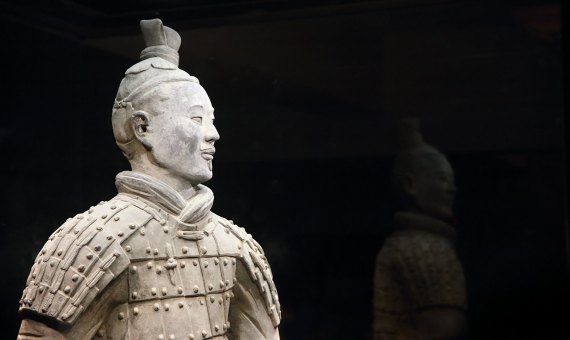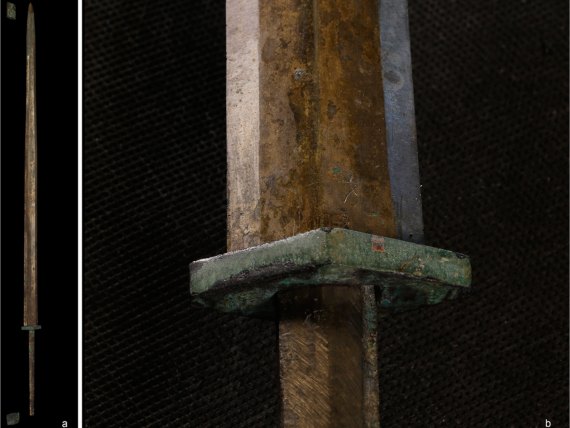On March 29, 1974, a team of workers digging a well near the Chinese city of Xian stumbled upon a unique find, a life-size terracotta warrior. Subsequent excavations unearthed one of the greatest archaeological discoveries in history. In three large pits near the tomb of Qin Shi Huang, the first emperor of unified China, lay a treasure that had remained hidden from the world for nearly 2,200 years: an entire terracotta army with more than 8,000 soldiers, 150 cavalry horses, 130 chariots pulled by 520 more horses and up to 40,000 arrowheads, along with dozens of swords, spears, crossbows and other bronze weapons. For decades, the terracotta warriors have provided work to generations of archaeologists. But even today, science continues to reveal secrets that the silent army has guarded for millennia.
The first emperor of the Qin dynasty was buried around 210 B.C. with a grandeur only comparable to that of the Pharaonic mausoleums of ancient Egypt. According to historian Sima Qian writing a century later, up to 700,000 men participated for several decades in the construction of a tomb whose interior mimicked a land with towers and palaces, among which ran a hundred rivers simulated with mercury, something attested to today by the high levels of this metal found in the ground.
However, not even the historical references hinted at the existence of the largest and most grandiose set of ceramic figures ever discovered. Analysis has revealed that the warriors were made up of separate pieces that were then joined together. Ten different moulds were used for the faces, which were then personalised by adding clay details so that each face was different from the others. The figures were glazed and painted with pigments of different colours, now almost disappeared, to achieve a final finish of a surprising realism.

Weapons in battle-ready condition
Chemical analyses revealed that the enamel applied to the figures contained chromium dioxide. When the bronze weapons were initially studied to unravel how they had been maintained for two millennia in battle-ready condition—shiny, corrosion-free and even sharp—chromium traces were also found on the pieces. This led to the suggestion that Chinese craftsmen in the 3rd century BC had already developed a process of chromium-plated metal that was not patented in the West until the beginning of the last century.
In recent years, the mysteries surrounding the Xian weapons have begun to be peeled back in detail thanks to a multidisciplinary research project coordinated by University College London and the Terracotta Army Museum in Xian, under the direction of Spanish archaeologist Marcos Martinón-Torres, currently at the University of Cambridge (United Kingdom). The scientists apply a wide range of analytical methods to find out what manufacturing techniques the Chinese blacksmiths used and even how they organised their work teams.

In this way, Martinón-Torres and his collaborators have been able to determine that the artisans of Xian’s weapons worked in parallel in autonomous groups of organisation similar to the just-in-time manufacturing method, which the Japanese automobile company Toyota introduced in the twentieth century, in contrast to the assembly line production method popularized by Ford company in the United States. But more recently, research by these scientists has led to a conclusion that topples an idea about the manufacture of the Xian weapons that has held sway in the minds of experts for four decades.
The Xian soil, a effective preservative
The team led by Martinón-Torres has discovered that the traces of chromium found in the weapons are not really the remnants of a chromium plating process, but a simple contamination from the enamel applied to the figures and the now- missing wooden components.
“We found a substantial chromium content in the lacquer, but only a trace of chromium in the nearby pigments and soil, possibly contamination,” says Martinón-Torres. “The highest traces of chromium found on bronzes are always on weapon parts directly associated to now-decayed organic elements, such as lance shafts and sword grips made of wood and bamboo, which would also have had a lacquer coating.” “Clearly, the lacquer is the unintended source of the chromium on the bronzes, and not an ancient anti-rust treatment,” concludes the archaeologist.
Instead, as the researchers explain in their study, published in the journal Scientific Reports, the perfect state of preservation of the bronze pieces is not the result of a final finish intended to prevent corrosion, but the product of the composition of the metal and the characteristics of the Xian soil, which acted as a more effective preservative than any chemical treatment. Thus, the moderately alkaline, fine-grained, sparsely aerated soil with little organic matter, along with the high tin content of bronze, worked together to preserve the weapons in perfect condition that has withstood the course of 22 centuries, while the world rose and empires fell.

To reach their conclusions, the researchers analysed an extensive sample of 464 bronze weapons, along with soil samples from Xian. An essential part of the research was an experiment of accelerated ageing of bronze in two chambers simulating the soil of the Chinese enclave and that of a place like Britain, respectively, subjecting the pieces to a temperature of 60 °C and a relative humidity of 90% for four months. In the British-type soil the deterioration of the metal was noticeable, which explains why old weapons found at British sites are heavily corroded.
“The chromium anti-rust treatment theory should therefore be abandoned,” write the researchers in their study. “Efforts should be made to update museum displays and other popular literature about the site with this new information.”
However, this does not preclude Chinese blacksmiths and artisans from having employed other conservation techniques to ensure that their legacy would endure through the immortal existence of their emperor. According to study co-author Xiuzhen Li, “it is still possible that the Qin Dynasty developed a mysterious technological process and this deserves further investigation.”
Comments on this publication